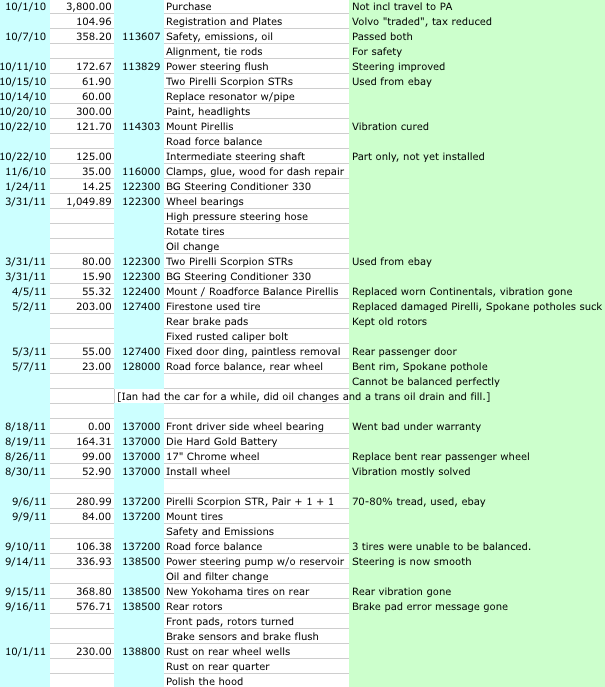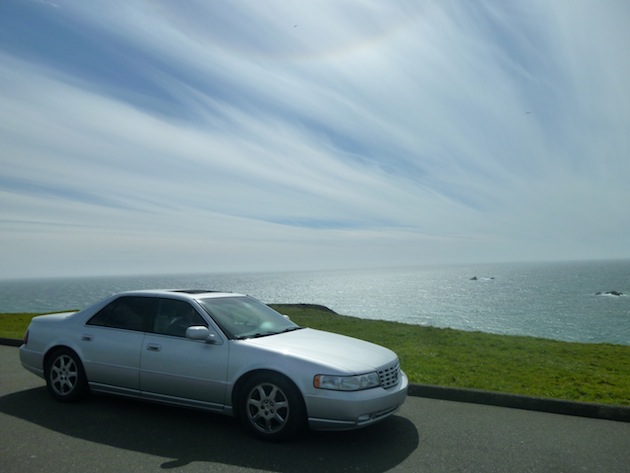





It’s easy enough to build a sports car. It’s easy enough to build a luxury sedan. Putting the two together, building a “sport sedan,” is a challenge, one that involves compromises, clever gadgetry, advanced materials, and computerization of everything from steering to suspension.
Therefore, it’s generally unwise to buy a used luxury car with more than 100,000 miles. While basic components like brakes, fluids, and hoses aren’t prohibitively expensive, the complexity lurking in the background involves a mess of sensors, computers, and specialized hardware to help what ought to be a lumpy land barge perform physics-defying athletics. It’s what makes the difference between a Toyota Avalon and a Cadillac Seville.
A $57,000 luxury car still requires the service level expected of a big-buck sedan, even if it depreciates down to $3800, which is what I paid for my 2001 Seville in October 2010.
The car came from T.A.R. Auto Sales in Wind Gap, PA, a hole in the wall town nestled into a mountainous area just north of Allentown and south of Scranton. I asked Ray, the owner, salesman, and the town’s mechanic, about overheating, as Northstar V8s have a tendency to blow head gaskets.
That road trip is documented here: http://jesda.com/2011/04/02/road-trip-roamed-the-country-searching-for-a-cadillac/
Head gasket repair on a front wheel drive Northstar V8-powered Cadillac requires removal of the engine, a job costing $2500-$3000.
Ray told me a story about an Eldorado he took on trade that ended up requiring a head gasket job, consuming dozens of hours of work before he could turn around and sell it. Sure, he could have poured in a “head gasket in a can” quick fix and turned a quick buck, but he didn’t. (A few shady Cadillac dealers in Florida have been doing that with trade-ins.)
He shared his technical knowledge and awareness of the problem and assured us that he’d been driving the car for thousands of miles to and from the shore without any trouble, proving it with the mileage on the title of the car when he took it in as a trade.
He was right — the car hasn’t had any overheating issues over the course of nearly 30,000 miles. Honesty is refreshing, isn’t it?
Unfortunately, Pennsylvania winters are brutal on automobiles, and a big part of the reason I was able to buy the car for so little was a bit of corrosion on the rear doors and rear wheel arches. The little rust bubbles on the wheel arches have reappeared and been repaired a couple times. The exhaust resonator was rusted out, so I had a muffler shop replace it with a straight pipe.
It’s never broken down or failed to start, no matter what, but some other odds and ends have needed attention.
Here’s a repair log:

GM’s 98-05 K-body cars (Sevilles, Devilles) are sensitive to wheel balancing issues, and used tires, while perfectly sufficient for other cars I’ve owned (with careful selection), are unsuitable for a Cadillac. It goes back to what I said about a $57,000 car requiring $57,000 levels of maintenance — shortcuts always cost more in the end.
Corrosion and paint work have cost just over $500, a price kept low thanks to a paint guy I use. Wheel bearings can be fairly expensive as well, a common failure item after 100,000 miles.
Other issues, like brakes, steering hardware, and the battery were pretty typical in terms of cost and expected failure rates. The battery, at $164, was expensive. The Seville uses a large vented unit installed under the rear seat.
Overall, most of the issues have been odds and ends, nothing serious or catastrophic. It’s been an exceptionally comfortable travel companion, seeing as much as 26mpg, even through mountainous areas.
It does consume a quart of oil every thousand miles, quite a nuisance when you’re well-dressed and clean and the “CHECK OIL LEVEL” message comes on. There’s nothing more unluxury than popping the hood at the gas station, cracking open a bottle of 10W30, and pouring it down the hatch while trying to keep your your nice shirt from getting stained.
I admittedly had some concerns as I embarked on a 9000-mile, 32-day road trip that took me to the Pacific, the Atlantic, and back. The Seville isn’t supposed to be a very reliable car, but I toured the Napa Valley, climbed the Rockies, dined on Pacific Northwest seafood, climbed the Appalachians, endured blizzards, and ran from a tornado in Kansas at 120mph, all through the course of one trip. It never let me down, ever.

Publications gave the Seville poor marks for reliability; Edmunds’ long-term test in 1998 was full of disappointments that revealed shockingly poor build quality and half-baked implementation of high-tech features, though it seems that by 2000, GM finally sorted out most issues. Unfortunately, they also sent angry customers running to Lexus dealerships — in 2000, Lexus bumped Cadillac from its long-held #1 position in the US luxury market.
The Seville lacks the durability of a Lexus, doesn’t handle like a 5-series, doesn’t ride like a Lincoln, nor does it offer the credibility of a Mercedes, but what it does well, it does exceptionally well. The whole is indeed greater than the sum of its parts, resulting in a superbly elegant, thoroughly satisfying, and much more expensive-feeling car than it is.
And despite what it’s cost to maintain, despite its portly 4000lb curb weight, and despite its somewhat cheap interior, this is still my all-time favorite luxury sedan, period. Everything I want or need in terms of styling, performance, technology, handling, and comfort is all there.
We’re now at 140,000 miles. Let’s see how far we can go.
Supplemental Reading:
Fourth and Fifth-Generation Seville Comparison
9000-Mile American Road Trip in the Seville
Cool article. Thanks for sharing!